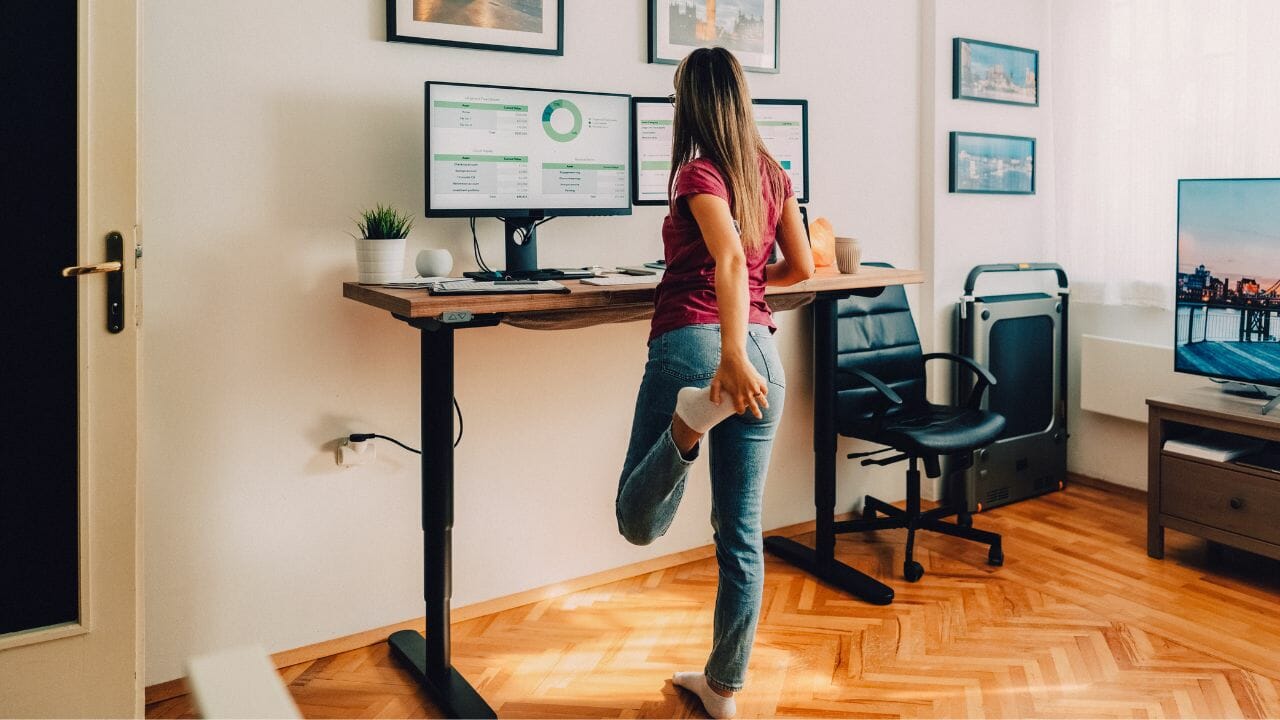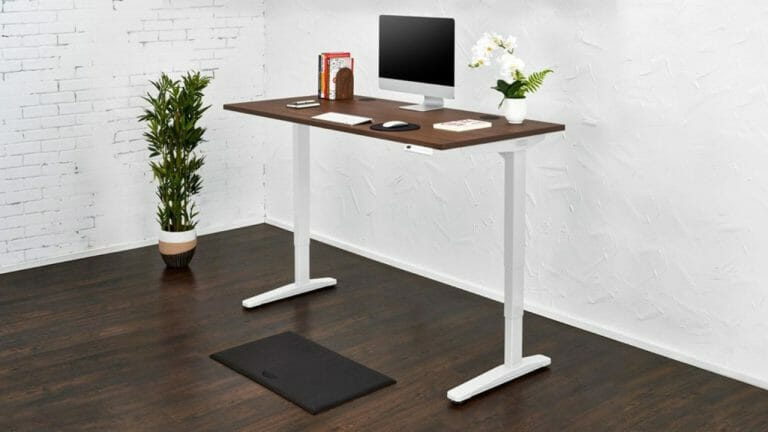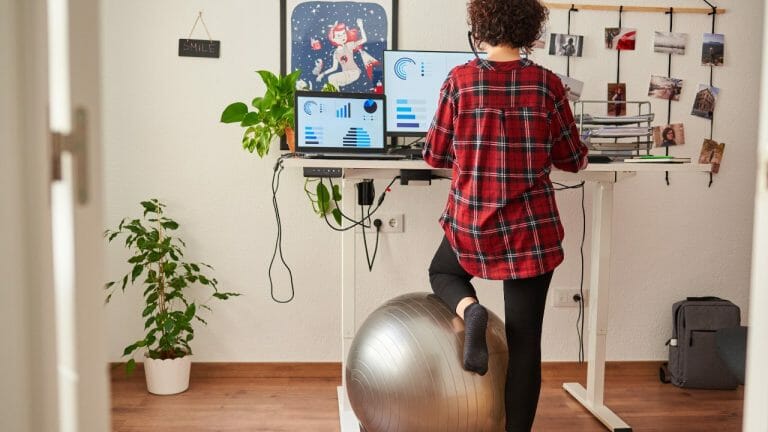Can Standing Desks Hurt Your Back?
Standing desks are advertised as something that cures back pain. But there are cases when users felt their standing desk was hurting their back. But is it true? And, if you are one of those users, what’s the reason behind this?
Standing desks hurt your back when you use them wrong. The reasons include positioning it wrong ( at an incorrect height), standing too long, or not maintaining a straight posture.
Whatever your reason might be, you have to learn every possibility. Only then can you identify why your back is hurting. So, are you ready to find out the truth and change the way you use a standing desk forever?
Why Does A Standing Desk Hurt Your Back?
We have come across five reasons why a standing desk hurts your back. Be prepared to see some of your daily practice in this list.
1. Not Positioned Correctly
The number one reason is not positioning your standing desk correctly. There’s a lot of misinformation regarding what the correct way is. The issue only worsens when two or more workmates use the same standing desk. The one-inch difference in height will require a slight adjustment in the desk height as well. But that’s not what we follow. It’s very common for 5’5” and 5’7” tall users to position the desk at the same height.
What’s The Right Way?
The right way is to measure your elbow height first. That means how high your elbow stands from the ground. Make sure you keep your hand straight while measuring. That’s the ideal standing height of your standing desk.
But if you don’t like the manual way, here’s a small chart to help you out.
| Height | Height (in cm) | Standing Desk height (in inches) |
|---|---|---|
| 5’2” | 157.5 | 33 |
| 5’4” | 162.5 | 35 |
| 5’5” | 165 | 36 |
| 5’7” | 170 | 38 |
| 6’ | 182.5 | 44 |
| 6’2” | 187 | 45 |
2. Not Letting Your Body Adjust
Have you started standing way too long right after bringing the desk home? If yes, you are in trouble. Our body requires time to adjust to a new setting. If you have worked sitting your whole life, it’s unfair not to let the body adjust before using a standing desk.
We have seen new users trying to stand for 30 minutes to one hour in front of the desk without a break. It starts like a challenge. But you soon realize your body is becoming stiff. And it gets worse every day.
What’s The Right Way?
The right way is to take breaks. Follow the 20-8-2 rule if it’s your first time. Sit for 20 minutes, and stand for the next 8 minutes. And finish it off by pacing around the desk for 2 minutes. Keep repeating this pattern until your body feels comfortable.
Once you have adjusted to the new workstyle, you can stand for 10 to 15 minutes straight every half an hour. The key is to stick with the routine.

3. Improper Posture
You are doing all this hard work to improve your posture, right? But if you are not standing straight while using the standing desk, how will your body change?
Most users are very accustomed to hunched shoulders. Even if they try to stand straight, it’s only a matter of minutes before they go back to their old way. That might be the reason your back pain doesn’t go away.
What’s The Right Way?
Stand straight in front of the desk. The spine should form its natural “S” shape as you do so. Keep your hands on the desktop. Make sure the elbow is at a 90 degrees angle. Don’t put all your weight on only one leg. When you do that, the pelvic discs get dislocated. Then, it can’t support the lower spine as it was supposed to.
To make things easier for you, try to do at least 10 minutes of yoga or stretching exercises regularly. Once your body becomes flexible, it will be much more comfortable for you to stand straight.
4. Standing On A Hard Surface
One mistake is standing too long from the start. But standing on a hard surface only makes your body suffer more.
Inflammation, varicose veins (purple or blue veins), and swollen feet are common symptoms if you are standing on an uncomfortable or hard floor. It can also happen when you press bare feet against a hard floor (tiles, marble, wooden), or you might be wearing very uncomfortable shoes (stiletto, platform heels). Both have the same effect on your body (lower back pain).
What’s The Right Way?
Instead, try to use an anti-fatigue mat under your feet. These mats keep your feet from sweating and engage them to find balance. The constant and slow movement makes sure there isn’t any part (be it tendons, soft tissues, etc) being suppressed for too long. It encourages blood circulation in your feet. So you don’t have to deal with lower-body pain afterward.
5. Incorrect Screen Position
Suppose your measurement tells you that the current standing desk is absolutely perfect. But there’s still one thing you might have missed. It’s the screen positioning.
In today’s time, there’s hardly any work-desk that doesn’t have a monitor. If that screen is not positioned right, you have to tilt your head to see the screen better. And such practice, if not checked, can cause back pain and neck pain.

What’s The Right Way?
We suggest you stand straight first. Remember the measurement we gave you for the ideal desk height? Let the desk rise up to that number. Now place the screen in the middle of the desk. Close your eyes and then slowly open them. What do you see first? If it’s the center of the screen, then you don’t have to make any more adjustments.
But suppose you see the border of your laptop or monitor screen. Increase the desk height slightly till the center of the screen is within your center of vision. Do the exact opposite if you end up seeing the bottom of the monitor first thing after opening your eyes. Hope that clarifies all trouble.
Another problem is where to keep the keyboard. If you adjust the desk to correct your screen positioning, you might not be able to maintain a 90 degrees angle with your elbow. For that, it becomes difficult to type something for a long time. We suggest you get a keyboard tray and place it under the desk. That way, both rules can be kept simultaneously.
Before You Go!
Just like sitting all day, standing all day is harmful to your body. Even medicines can benefit us if taken in a prescribed amount. So, don’t make the mistake of standing too long in front of your desk. Check out our discussion on how long is too long for a standing desk.



![Is Standing Desk Better For Posture? [4 Better Posture Guide]](https://homethereby.com/wp-content/uploads/2022/07/How-Much-Should-You-Spend-On-A-Standing-Desk-2-768x432.jpg)
![Does Standing Desk Burn Calories? [Or A Myth?]](https://homethereby.com/wp-content/uploads/2023/03/T-Leg-vs-C-Leg-Standing-Desks-768x432.jpg)

![Do Electric Standing Desks Break? [Honest Answer]](https://homethereby.com/wp-content/uploads/2022/07/Do-Electric-Standing-Desks-Break-768x432.jpg)
